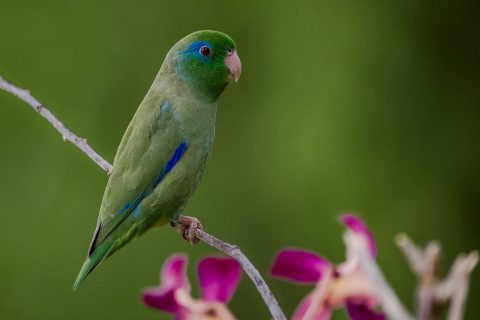The blackish owl (Asio stygius) is a species of strigiform bird belonging to the genus Asio that is part of the family Strigidae. It is native to the Neotropics.
It measures between 38 and 46 cm weighing between 632 and 675 g, the female is heavier. Large and understated, her entire appearance is somber. It has two long tufts of black feathers on its head that are mistaken for «ears» or «horns». Yellow-orange eyes. Brownish-black face with whitish eyebrows and a clearly visible light spot on the forehead between the “ears”. Dorsal parts black-brownish with scattered light spots. Underparts buffy or dirty white with the chest all dark stained and thick black-brownish stripes in the shape of a herringbone in the rest; blackish outer shirts. Tail dark brown barred brown. Her fingers are bear with feathered tarsi. The beak is black.

The Green (Mexican) violetear (Colibri cyanotus) it is a species of apodiform bird in the Trochilidae family is a medium-sized, metallic green hummingbird species commonly found in forested areas from Mexico to Nicaragua. This species, together with the lesser violetear were previously considered conspecific, and together called the green violetear.
The collared inca (Coeligena torquata) is a species of hummingbird found in humid Andean forests from western Venezuela, through Colombia and Ecuador, to Peru and Bolivia. It is very distinctive and unique in having a white chest-patch and white on the tail. Like other hummingbirds it takes energy from flower nectar (especially from bromelias), while the plant benefits from the symbiotic relationship by being pollinated. Its protein source is small arthropods such as insects. It is normally solitary and can be found at varying heights above the ground, often in the open.
The ferruginous pygmy owl (Glaucidium brasilianum) is a small owl that breeds in south-central Arizona and southern Texas in the United States, south through Mexico and Central America, to South America into Bolivia, Colombia, Paraguay and Argentina.
The Flame-faced Tanager has a bright orange forehead and cheeks which grade to yellow on the rest of the head. It has a black throat and ear patcher. The upperparts are black with a greenish-yellow shoulder patch and yellow and greenish-buff rump. The underparts are greenish-buff grading to rufous toward the belly. It is similar to the Saffron-crowned Tanager but is distinguished by having a black back and greenish buff underparts.
White-winged Doves are plump, square-tailed doves with relatively long, thin bills and small heads. They are brown overall, with a dark line on the cheek. A white stripe at the edge of the folded wing becomes, as the bird takes flight, a bright flash in the middle of a dark wing. The tail is tipped in white and set off with black stripes from the gray underside. Their faces are ornately marked with a black streak on the cheek, and blue skin around the red eyes.
The White-sided Flowerpiercer (Diglossa albilatera) is a species of bird of the Thraupidae family that lives in South America. They are called flower pricks or nectar steals, it is considered that with its task of extracting nectar from flowers it helps the pollination of native plants (Brachyotum strigosum, Macleania rupestris, Eucalyptus globulus, Clusia multiflora, Axinaea macrophylla and Gaiadendron punctatum).
The American kestrel (Falco sparverius) is the smallest and most common falcon in North America. It has about a two to one range in size over subspecies and sex, varying in size from about the weight of a blue jay to a mourning dove. It also ranges to South America, and is a well-established species that has evolved seventeen subspecies adapted to different environments and habitats throughout the Americas. It exhibits sexual dimorphism in size (females being moderately larger) and plumage, although both sexes have a rufous back with noticeable barring. Its plumage is colorful and attractive, and juveniles are similar in plumage to adults.
The spectacled parrotlet (Forpus conspicillatus) is a species of parrot in the family Psittacidae. It is the nominate species (Forpus conspicillatus conspicillatus).
There are two subspecies: the Cauca spectacled parotlet (F. c. caucae) and the Venezuelan spectacled parotlet (F. c. metae).
The grey-breasted mountain toucan (Andigena hypoglauca) is a species of bird in the family Ramphastidae found in humid highland forest, often at the tops of the trees, in the Andes of southern Colombia, Ecuador and Peru. It remains locally fairly common, but has declined due to habitat loss.












